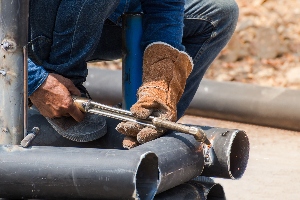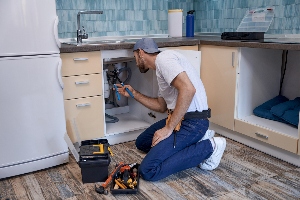Biofilm formation in drains is a process where bacteria, fungi, and other microorganisms establish a colony, creating a slimy, glue-like substance that sticks to the drain surfaces. When you flush water down the drain, you might unwittingly contribute to this microenvironment, as organic matter and particles can serve as food for the biofilm community, leading to its growth. This can cause blockages and emit unpleasant odors, and in some cases, it may even become a breeding ground for harmful pathogens.
Maintenance is key to dealing with biofilm in drains. By understanding how these communities thrive, you can implement strategies that keep your drains clear and hygienic. Routine cleaning with appropriate products disrupts the biofilm before it becomes problematic. Specialized cleaners are designed to penetrate the biofilm matrix, reaching and neutralizing the embedded microorganisms.
Ensuring that your drains remain dry when not in use can also be effective, as biofilms require moisture to maintain their structure and function. In healthcare settings, where the stakes are significantly higher due to the potential for disease transmission, meticulous attention to plumbing system maintenance and disinfection is crucial. Regular inspections and cleaning can help prevent bacterial proliferation and biofilm development, preserving a safe and clean water system.
Biofilm Formation in Drains
In drain systems, biofilms develop through a sophisticated and multi-step process that creates tough to eradicate bacterial colonies. Your awareness of these mechanisms is critical for effective control and prevention.
Mechanisms of Biofilm Development
Initially, single bacteria float freely but eventually make contact with the drain surface. Attachment is the first crucial phase, where bacteria adhere to the surface using their appendages. Following attachment, bacteria secrete extracellular polymeric substances (EPS), forming a protective matrix that anchors the community. This leads to microcolony formation and the eventual maturation of the biofilm. Mature biofilms can release bacteria back into the environment, a process known as dispersion, potentially leading to the spread or establishment of new biofilms further in the drainage system.
Factors Influencing Biofilm Growth in Drains
Several factors influence biofilm growth in drain systems:
- Nutrient Availability: Ample organic matter in drains supports biofilm development.
- Moisture Levels: Drains provide a consistently moist environment, ideal for biofilm sustenance.
- Surface Material: The type of surface material impacts the ease with which biofilms adhere and develop.
- Temperature: Warmer temperatures typically promote faster bacterial growth.
- Chemical Exposure: Regular use of disinfectants can influence the composition and resilience of a biofilm.
By understanding the development mechanisms and influential factors, you can better approach the prevention and treatment of biofilms in drain systems.
Consequences of Biofilm Accumulation
When biofilms build up in your drains, they cause significant issues affecting both functionality and health. Understanding these impacts is crucial for maintaining a safe and efficient drainage system.
Impact on Drain Functionality
Biofilms can reduce the diameter of drain pipes due to their accumulation, leading to slower drainage and potential blockages. This can escalate to water backing up or even causing a complete clog in your plumbing system. Furthermore, biofilms may corrode the pipe material, leading to costly repairs and replacements.
- Reduced Flow Rate: Slowing down the water drainage.
- Blockages: Complete obstruction of pipes, requiring professional intervention.
- Pipe Corrosion: Potential damage to pipe integrity due to biofilm acids.
Health Risks Associated with Biofilms
Biofilms serve as a refuge for bacteria, including potential pathogens. This makes your drains a health risk due to:
- Foul Odors: Byproducts from bacterial metabolism can emit noxious smells.
- Pathogen Growth: Harmful bacteria within biofilms can contaminate your environment, increasing the risk of infections.
Regular cleaning and maintenance are essential to control these risks and ensure your drainage system remains functional and safe.
Detection and Monitoring of Biofilms
Detecting and monitoring biofilms in drains is a critical step in maintaining a sanitary environment. By using a combination of visual inspection and advanced methods, you can effectively identify and quantify biofilm presence.
Visual Inspection Techniques
You can begin the detection process through direct visual inspection. Look for any slimy, colored, or cloudy substances lining the interior of drains. These physical signs are often indicative of biofilm formation. Visual inspection can also involve the use of boroscopes, which are flexible cameras that allow for a closer examination of the drainpipe interiors.
Advanced Biofilm Detection Methods
Beyond mere observation, advanced methods enable a more precise detection of biofilms:
- Non-invasive sensors: Utilize sensors that detect changes caused by biofilm formation without altering the system.
- Microbial testing: Take swab samples from suspected areas and culture them in a laboratory setting to determine the presence of bacteria indicative of biofilms.
- Molecular techniques: Implement DNA-based methods such as PCR (polymerase chain reaction) to identify biofilm-producing microorganisms at a genetic level.
- Physical and chemical analysis: Use techniques such as spectrophotometry or high throughput staining that react with components of the biofilm, providing visual confirmation.
Each method comes with its advantages and suitability for different stages of biofilm growth, contributing to a thorough monitoring strategy.
Preventive Strategies for Biofilm Control
Effective control of biofilms in drainage systems can mitigate a significant public health risk. By focusing on design optimization and proactive treatments, you can prevent the onset of biofilm establishment.
Design and Maintenance of Drainage Systems
Proper design: A key preventive strategy is the correct design of the drainage system to minimize stagnant water where biofilms can form. Ensure smooth surfaces and adequate slopes for self-cleaning velocity.
Regular maintenance: Perform routine inspections and cleaning to promptly remove any beginnings of biofilm formation. Materials resistant to biofilms, like copper, can also be incorporated into design selections.
Chemical and Biological Preventive Approaches
Chemical agents: Utilize chemical agents such as chlorine, bromine, or oxidizing biocides to disrupt biofilm formation. It is crucial to apply the correct concentration for these agents to be effective and safe.
Biological methods: Introduce bacteriophages or probiotic bacteria that target biofilm-forming bacteria. This approach can be used as a part of an integrated management strategy to control the growth of harmful microbial colonies in drains.
Removal and Eradication of Biofilms
Removing and eradicating biofilms from drains is crucial to prevent bacterial growth and maintain hygiene. This involves applying mechanical methods, chemical disinfectants, and exploring emerging technologies.
Mechanical Cleaning Methods
You can physically remove biofilms through scrubbing and high-pressure washes. This dislodges the biofilm's structure, making it more susceptible to other eradication methods.
- Brushing: Use a stiff brush to scrub the surfaces.
- Sonication: High-frequency sound waves can disrupt biofilms.
Chemical Disinfection
For chemical disinfection, you can use biocides or disinfectants that dismantle the protective matrix and kill the bacteria within the biofilm.
- Chlorine: An effective and commonly used disinfectant.
- Quaternary Ammonium Compounds: Suitable for various surfaces.
Emerging Technologies for Biofilm Removal
You should be aware of new strategies in development, including enzymes and bacteriophages, which target biofilms more precisely.
- Enzymatic treatments: Break down the biofilm's matrix.
- Bacteriophages: Viruses that can target and destroy bacteria within biofilms.
Regulatory Standards and Best Practices
Your awareness of regulatory standards and adherence to best practices are critical in managing biofilm and bacterial growth in drains.
Industry Guidelines for Drain Maintenance
To mitigate biofilm and bacterial growth in your drains, it's essential to follow industry guidelines. Regular cleaning and inspection schedules should be a part of your routine. Utilize:
- Enzymatic cleaners: These can break down organic matter effectively.
- Mechanical cleaning tools: To physically remove biofilm layers.
- Temperature checks: Use hot water flushes as high temperatures can disrupt biofilm.
Compliance with Health and Safety Regulations
Ensure your drain maintenance program complies with health and safety regulations. This includes:
- Monitoring water quality as prescribed by equipment manufacturers.
- Discharging water and air for 20-30 seconds after each use to prevent stagnation.
- Recording maintenance activities for accountability and regulatory inspections.
Future Directions in Biofilm Management
The future of biofilm management in drains is poised to transform with the advent of advanced materials and smart technologies that target biofilm formation more effectively.
Innovative Materials and Coatings
In your quest to mitigate biofilm growth, innovative materials and coatings are being developed. Antimicrobial coatings, for instance, can play a pivotal role. These are typically embedded with substances that reduce biofilm adherence and viability. Materials like copper and silver have gained attention due to their natural antimicrobial properties. These substances may be integrated into drain materials or applied as coatings to prevent biofilm formation.
Moreover, research is exploring the use of enzyme-impregnated materials. Enzymes like DNase or proteases break down extracellular polymeric substances (EPS), which are key to biofilm stability. Utilizing these materials for drain construction could disrupt biofilm matrix development and facilitate easier cleaning.
Smart Drain Systems
Smart drain systems represent a leap forward in biofilm management. You may soon find drains equipped with embedded sensors that detect biofilm growth in real-time. This allows for timely interventions before blockages occur.
Automated cleaning mechanisms are another promising development. These systems could employ periodic flushing with biofilm-disrupting agents like antibacterial solutions or phage therapy, targeting biofilm without manual intervention. Furthermore, feedback-loop systems may adjust cleaning frequency and intensity based on biofilm detection levels, ensuring that cleaning is both efficient and resource-conserving.
Case Studies and Real-World Examples
When exploring the impact of biofilms on drain systems, various studies have provided insights into their composition and control measures. For instance, a real-world example is the formation of biofilms in hospital drains. A study conducted on hospital drain biofilms has identified a mix of 119 species of both Gram-positive and Gram-negative bacteria within this environment. These biofilms can be resistant to certain disinfectants, but the study reported that sodium hypochlorite (NaOCl) was effective, achieving a greater than 4 log reduction in bacterial viability in certain parts of the drain.
In full-scale drinking water systems, biofilms can also have significant implications. Bacterial release from pipe biofilms into distributed water has been quantified, with findings showing an average of 2.1 × 10^3 cells/mL being released. This emphasizes the dynamic nature of biofilms and the necessity for monitoring and control within drinking water infrastructure.
Selected Interventions:
- Sodium hypochlorite (NaOCl): Effective in significant bacterial viability reduction in drain biofilms.
- Peroxyacetic acid (PAA): Prevented biofilm regrowth for more than 4 days after treatment.
- Nutrient control: Changes in nutrient content can affect biofilm dispersion, thus controlling environmental variables can be a strategy for biofilm management.
These examples underscore the challenges you face with biofilm management in various contexts, from hospital drains to drinking water systems. Understanding the efficacy of different disinfectants and the factors influencing biofilm growth and dispersion can guide your efforts in controlling these microbial communities.
Conclusion
In the environment of drains, biofilm formation is a significant concern due to its capacity to house harmful bacteria. Your understanding of biofilm's impact and management is crucial in maintaining hygiene and preventing the spread of infection.
Persistence: Once established, biofilms are challenging to eradicate. They resist common disinfection methods, making your routine cleaning less effective.
Implications for Health: The bacteria protected within biofilms can contribute to healthcare-associated infections (HAIs) if they contaminate medical devices or come in contact with vulnerable patients.
Possible Solutions:
- Regular and thorough cleaning, using products that can penetrate biofilms.
- Implementing physical removal techniques such as brushing or high-pressure water jets.
- Investigating and applying antimicrobials known to disrupt biofilm structure.
Prevention is better than cure in the context of biofilms in drains:
- Employ preventive measures to limit biofilm development.
- Monitor high-risk areas and deploy targeted cleaning protocols.
By taking these informed steps, you can effectively manage biofilm and bacterial growth, safeguarding health and maintaining a cleaner environment.
Book your professional drain clean in Greenville with One Call Plumbing.












